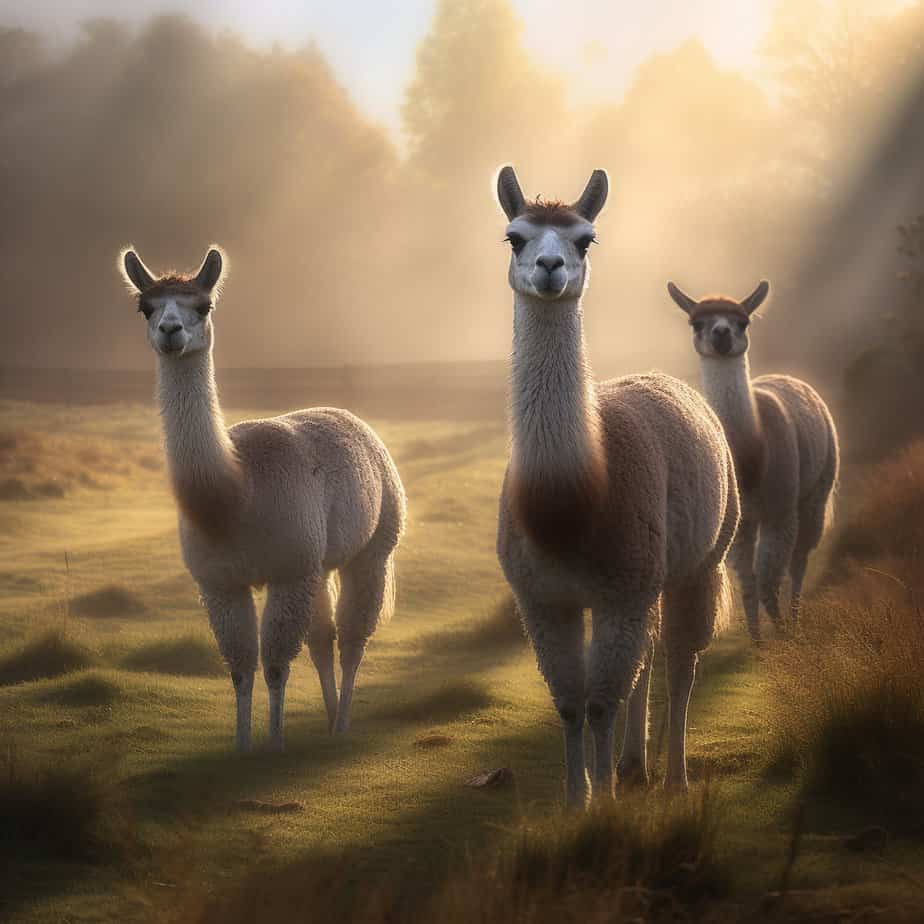Llamas are fascinating creatures that have captured the hearts of many people around the world. Known for their unique appearance and gentle demeanor, these South American camelids have gained a reputation for being friendly and sociable animals. In this article, we will explore the question, “Are llamas friendly?” and delve into the various aspects of their behavior and interactions with humans. Whether you are considering getting a llama as a pet or simply curious about these intriguing animals, read on to discover more about their friendly nature and the joys of being in their company.
Key Takeaways
- Llamas can be friendly and sociable animals.
- However, their friendliness can vary depending on their individual personality and upbringing.
- Proper handling, socialization, and training can help promote friendliness in llamas.
- It is important to approach llamas with caution and respect their boundaries to maintain a positive interaction.
The Llama Persona: Unraveling the Mystery
A. Why are Llamas so Cute?
Llamas have an undeniable charm that captivates people of all ages. Their endearing appearance, with their fluffy coats, expressive eyes, and long necks, makes them undeniably cute. But what exactly makes llamas so adorable?
One reason is their unique facial expressions. Llamas have a way of tilting their heads and peering at you with curiosity, which can melt even the coldest of hearts. Their long eyelashes and gentle demeanor only add to their appeal. Additionally, llamas have a natural grace and elegance in their movements, making them a delight to watch.
Another factor that contributes to their cuteness is their fluffy wool. Llamas come in a variety of colors, from white and beige to brown and black, and their wool is soft and warm. Their woolly appearance gives them a cuddly and huggable quality that many find irresistible.
B. The Misunderstanding: Why are Llamas Perceived as Mean?
Despite their inherent cuteness, llamas have gained a reputation for being mean or aggressive. This misconception stems from a few misunderstandings about their behavior.
Firstly, llamas are highly protective of their herd. They have a strong instinct to guard their group and can exhibit defensive behavior if they feel threatened. This can include spitting, kicking, or charging at perceived threats. However, it’s important to note that llamas typically reserve these behaviors for self-defense and are not inherently mean-spirited.
Secondly, llamas are naturally cautious animals. They have a keen sense of awareness and may be wary of unfamiliar people or situations. This wariness can sometimes be misinterpreted as aggression. However, with proper handling and socialization, llamas can become friendly and trusting companions.
It’s also worth mentioning that individual llamas have unique personalities, just like humans. Some llamas may be more outgoing and sociable, while others may be more reserved or independent. It’s essential to approach each llama with patience, respect, and understanding to build a positive relationship.
C. The Llama-Alpaca Dichotomy: How are Llamas Different than Alpacas?
Llamas and alpacas are often confused with each other due to their similar appearances. While they belong to the same family, Camelidae, and share some characteristics, there are distinct differences between the two.
Size is one noticeable difference. Llamas are generally larger than alpacas, both in height and weight. Llamas can reach up to 6 feet tall at the shoulder and weigh between 280 to 450 pounds, while alpacas are smaller, standing around 3 feet tall and weighing between 100 to 200 pounds.
Another difference lies in their purpose. Llamas have historically been used as pack animals, capable of carrying heavy loads over long distances. They have a sturdy build and are known for their strength and endurance. On the other hand, alpacas were primarily bred for their luxurious wool, which is softer and finer than llama wool. Alpacas are also more commonly kept as pets or for their fiber.
In terms of temperament, llamas are generally more independent and protective, while alpacas tend to be more docile and gentle. Llamas have a natural instinct to guard their herd and may exhibit more assertive behaviors, whereas alpacas are known for their calm and friendly nature.
Understanding the distinctions between llamas and alpacas is crucial, especially for those considering them as pets or companions. Each animal has its own unique characteristics and requirements, so it’s essential to research and choose the right fit for your lifestyle and preferences.
In conclusion, llamas are undeniably cute creatures with their fluffy coats, expressive eyes, and graceful movements. While they may have a reputation for being mean or aggressive, this is often a misunderstanding of their natural behaviors. With proper handling, socialization, and respect for their individual personalities, llamas can be friendly and affectionate companions. Additionally, it’s important to differentiate between llamas and alpacas, as they have distinct characteristics and purposes. By unraveling the mystery of the llama persona, we can appreciate these fascinating animals for the unique and lovable creatures they are.
Comparing Friendliness: Llamas vs. Alpacas
A. Are Llamas Friendlier than Alpacas?
When it comes to comparing the friendliness of llamas and alpacas, it’s important to understand that each animal has its own unique personality. While both llamas and alpacas can be friendly and sociable, there are some differences in their behavior and temperament.
Llamas are known for their curious and outgoing nature. They are often described as more confident and assertive compared to alpacas. Llamas are generally more comfortable around people and may approach them with curiosity. They are also known to be more receptive to training and can be taught to walk on a leash or perform simple tasks.
On the other hand, alpacas are typically more reserved and cautious. They tend to be more skittish and may take longer to warm up to unfamiliar people. Alpacas are known for their gentle and calm demeanor, but they may require more time and patience to build trust and establish a bond.
B. Llamas or Alpacas: Which is More Friendly?
Determining which animal is more friendly, llamas or alpacas, ultimately depends on individual preferences and the specific needs of the owner. Both llamas and alpacas can make wonderful companions, but their friendliness may manifest in different ways.
Llamas, with their outgoing and confident nature, can be more interactive and engaging. They may readily approach people and seek attention and interaction. Llamas can be great for those seeking a more active and engaging relationship with their animal companion.
On the other hand, alpacas, with their calm and gentle demeanor, can provide a sense of tranquility and comfort. They may not seek as much attention or interaction as llamas, but they can still form strong bonds with their owners. Alpacas are ideal for those who prefer a more relaxed and peaceful companionship.
It’s important to note that both llamas and alpacas are herd animals and thrive in the company of their own kind. Keeping them in pairs or small groups can enhance their well-being and social behavior. Additionally, proper socialization and positive reinforcement training can help foster friendliness in both llamas and alpacas.
In conclusion, while llamas and alpacas have their own unique personalities, both can be friendly and make great companions. Whether you prefer the outgoing and interactive nature of llamas or the calm and gentle demeanor of alpacas, both animals can bring joy and companionship into your life.
Llamas as Companions: Are They Suitable Pets?

A. The Benefits of Having Llamas as Pets
Llamas are fascinating creatures that have gained popularity as pets in recent years. These gentle and sociable animals offer a range of benefits to their owners. If you’re considering getting a pet llama, here are some reasons why they make great companions:
-
Calming Presence: Llamas have a naturally calm and serene demeanor, which can have a positive impact on your mental well-being. Spending time with these peaceful animals can help reduce stress and anxiety.
-
Unique Personality: Each llama has its own distinct personality, making them interesting and enjoyable to be around. Some llamas are playful and curious, while others are more reserved and observant. Getting to know your llama’s individual traits can be a rewarding experience.
-
Low Maintenance: Llamas are relatively low-maintenance pets. They have simple dietary needs, primarily consisting of grass and hay. They also require regular grooming to keep their coats clean and free from tangles. Additionally, llamas are hardy animals that can adapt to various climates, making them suitable for different regions.
-
Versatile Companions: Llamas can serve multiple purposes, depending on your needs. They can be excellent therapy animals, providing comfort and companionship to individuals in need. Llamas can also be trained for activities such as hiking, packing, and even agility courses.
-
Eco-Friendly Grazers: If you have a large property or a farm, llamas can be beneficial for vegetation management. They are natural grazers and can help control weeds and overgrown areas without causing damage to the environment.
B. Do Llamas Need a Companion?
Llamas are highly social animals that thrive in the company of their own kind. While they can form strong bonds with humans, it is generally recommended to have at least two llamas to ensure their well-being. Here’s why:
-
Herd Animals: Llamas are herd animals by nature, and they have a strong instinct to live in groups. Having a companion llama provides them with the social interaction they need to feel secure and content.
-
Llama Language: Llamas communicate with each other through a variety of vocalizations, body language, and behavior. When llamas are together, they engage in activities such as grooming, playing, and even communal dung piles. These interactions are essential for their mental and emotional health.
-
Preventing Loneliness: Llamas can experience loneliness and stress if they are kept alone for extended periods. They may exhibit behaviors such as pacing, vocalizing excessively, or even becoming aggressive. Having a companion llama helps prevent these issues and ensures a happier and healthier pet.
-
Human Interaction: While llamas enjoy the company of their own kind, they can also form strong bonds with their human caregivers. However, human interaction alone may not be enough to fulfill all their social needs. Having another llama companion provides them with a more natural and fulfilling social environment.
In conclusion, llamas make wonderful companions and pets. Their calm demeanor, unique personalities, and low-maintenance nature make them a great choice for those seeking a unique and rewarding pet experience. Additionally, having at least two llamas ensures their social well-being and prevents loneliness. So, if you’re considering getting a pet llama, be prepared to welcome them into a social and loving environment.
The Human-Llama Bond: Are Llamas Nice to Humans?
A. Are Llamas Friendly to Humans?
Llamas are known for their gentle and friendly nature, making them great companions for humans. While each llama has its own unique personality, they are generally friendly and sociable animals. Llamas have been domesticated for thousands of years, and their interactions with humans have shaped their behavior to be more amicable.
One of the reasons why llamas are friendly to humans is their natural curiosity. They are intelligent creatures that enjoy exploring their surroundings and interacting with new people. When approached with kindness and respect, llamas often respond positively and can even form strong bonds with their human caretakers.
Unlike some other animals, llamas do not have a strong predatory instinct, which contributes to their friendly demeanor. They are herbivores and have no interest in hunting or attacking humans. This lack of aggression makes them safe and approachable, especially for those who may be wary of larger animals.
B. How to Call a Llama: Building a Connection
Building a connection with a llama can be a rewarding experience. Here are some tips on how to call a llama and establish a bond:
-
Approach calmly: When approaching a llama, it’s important to remain calm and move slowly. Sudden movements or loud noises may startle them. Approach from the side rather than head-on, as this can be less intimidating.
-
Use a gentle voice: Llamas respond well to a gentle and soothing voice. Speak softly and use a friendly tone to communicate with them. This can help them feel at ease and more willing to interact with you.
-
Offer treats: Llamas are motivated by food, so offering them treats can be a great way to build trust and establish a positive association. However, it’s important to choose llama-friendly treats, such as hay or specially formulated llama treats, to ensure their nutritional needs are met.
-
Respect their boundaries: While llamas are generally friendly, it’s important to respect their personal space. Avoid crowding or overwhelming them with too much physical contact. Allow them to approach you at their own pace and be mindful of their body language.
-
Provide positive reinforcement: When a llama responds positively to your presence or commands, reward them with praise or a gentle pat. Positive reinforcement can help reinforce good behavior and strengthen the bond between you and the llama.
Remember, building a connection with a llama takes time and patience. Each llama is unique, and it’s important to understand and respect their individual boundaries and preferences. With consistent care and positive interactions, you can develop a strong and friendly bond with these remarkable animals.
| Tips for Building a Connection with Llamas | |——————————————–| | – Approach calmly and slowly | | – Use a gentle voice | | – Offer llama-friendly treats | | – Respect their boundaries | | – Provide positive reinforcement |
The Utility of Llamas: How are Llamas Helpful?

Llamas are fascinating creatures that have been domesticated for thousands of years. They have proven to be incredibly useful in a variety of ways, making them an integral part of various cultures around the world. Let’s explore the different roles that llamas play and how they contribute to our lives.
A. What are Llamas Farmed for?
Llamas are not just adorable animals to have around; they serve a practical purpose on farms and in communities. Here are some of the reasons why people choose to farm llamas:
-
Fiber Production: Llamas have a luxurious coat that can be shorn annually, providing high-quality fiber. This fiber, known as llama wool, is soft, warm, and hypoallergenic, making it ideal for clothing and textiles. Llama wool is highly sought after for its durability and natural insulation properties.
-
Pack Animals: Llamas have an incredible ability to carry heavy loads. Their strong backs and surefootedness make them excellent pack animals, capable of navigating challenging terrains. They can carry supplies, equipment, and even camping gear, making them invaluable companions on long hikes or treks.
-
Guard Animals: Llamas have a natural instinct to protect their herd. They are known for their alertness and territorial behavior, which makes them excellent guard animals. Llamas can be trained to protect livestock such as sheep, goats, and even poultry from predators like coyotes and foxes. Their presence alone is often enough to deter potential threats.
-
Companionship: Llamas are highly social animals and can provide companionship to humans and other animals. Their gentle and curious nature makes them wonderful companions, particularly for those living in rural areas or on large properties. Llamas can form strong bonds with their owners and offer a sense of comfort and joy.
B. The Specialized Roles of Llamas in Various Cultures
Llamas have played significant roles in various cultures throughout history. Here are a few examples of how llamas have been utilized in different parts of the world:
| Culture | Role of Llamas | |———|—————-| | Inca Empire | The Inca civilization in South America relied heavily on llamas for transportation, as they were the primary means of carrying goods across the Andes Mountains. Llamas were also a source of food, wool, and even sacrificial offerings. | | Native American Tribes | Many Native American tribes, such as the Navajo and Hopi, have long-standing traditions of raising llamas. Llamas were used for their wool, which was spun into yarn and woven into intricate textiles. They were also used as pack animals for trading and transportation. | | Modern Therapy Programs | Llamas are increasingly being used in therapy programs to provide emotional support and comfort. Their calm and gentle demeanor can have a positive impact on individuals struggling with anxiety, depression, or trauma. Interacting with llamas has been shown to reduce stress and promote relaxation. |
As we can see, llamas have proven to be incredibly versatile and helpful creatures. Whether they are providing wool for clothing, carrying heavy loads, protecting livestock, or simply offering companionship, llamas have earned their place in our lives and hearts.
In the next section, we will delve deeper into the fascinating world of llama behavior and interaction with humans. Stay tuned to discover more about these friendly and fascinating animals!
The Origins and Habitats of Llamas and Alpacas
Llamas and alpacas are fascinating animals that have a rich history and are well-adapted to specific habitats. Let’s explore where these unique creatures come from and where they can be found in the world.
A. Where Do Llamas and Alpacas Come From?
Llamas and alpacas have their origins in South America, specifically in the Andean region. These animals have been domesticated for thousands of years and have played a significant role in the lives of the indigenous people of the Andes.
The ancestors of llamas and alpacas are believed to have roamed the region millions of years ago. Over time, through selective breeding, these animals have evolved into the domesticated forms we see today. Llamas and alpacas are closely related to each other and share a common ancestor.
B. Where are Llamas Found?
Llamas are primarily found in the highlands of the Andes Mountains, spanning several countries including Peru, Bolivia, and Ecuador. These rugged terrains with their high altitudes and harsh climates are perfectly suited for llamas. They have adapted to thrive in these challenging environments, making them an integral part of the Andean culture and economy.
Alpacas, on the other hand, are also native to the Andean region but are primarily found in Peru. They are well-suited to the high-altitude grasslands and mountainous regions of the country. Alpacas have been selectively bred for their luxurious fleece, which is highly prized for its softness and warmth.
Both llamas and alpacas have been introduced to other parts of the world, including North America, Europe, and Australia. In these regions, they are often kept as pets, used for their wool, or utilized in therapy programs due to their gentle nature and calming presence.
To summarize, llamas and alpacas originate from the Andean region of South America and have adapted to thrive in the high-altitude environments of the Andes Mountains. While llamas are found in several countries across the region, alpacas are primarily concentrated in Peru. These remarkable animals have also been introduced to other parts of the world, where they continue to captivate people with their unique characteristics and friendly demeanor.
Understanding Llama Behavior and Preferences

A. What are Llamas’ Favorite Food?
Llamas are herbivores, meaning they primarily eat plants. Their diet consists mainly of grass, hay, and other vegetation. However, llamas have their preferences when it comes to food. Let’s take a closer look at what llamas enjoy munching on:
-
Grass: Llamas love grazing on fresh, green grass. They have a knack for finding the juiciest patches and can spend hours contentedly nibbling away.
-
Hay: Hay is a staple in a llama’s diet, especially during the winter months when fresh grass is scarce. Llamas prefer high-quality hay that is free from mold and dust.
-
Leaves and Shrubs: Llamas also enjoy browsing on leaves and shrubs. They may nibble on tree branches or snack on the leaves of bushes and shrubs.
-
Grains and Pellets: While not a natural part of their diet, llamas can be fed small amounts of grains and pellets as treats or supplements. However, it’s important to consult with a veterinarian or a knowledgeable llama caretaker before introducing these into their diet.
It’s worth noting that llamas have sensitive digestive systems, so sudden changes in their diet can cause health issues. It’s best to introduce new foods gradually and monitor their response.
B. The Truth Behind the ‘Mean’ Llama: Why are Llamas Mean?
Llamas have gained a reputation for being mean or aggressive, but this is not entirely accurate. Like any animal, llamas have their own personalities and temperaments. While some llamas may display aggressive behavior, it is not a characteristic of the entire species. Here are a few reasons why a llama might exhibit mean behavior:
-
Fear or Stress: Llamas may become defensive or aggressive when they feel threatened or stressed. This can happen if they are in an unfamiliar environment, surrounded by loud noises, or approached too quickly by a stranger.
-
Protective Instincts: Llamas are naturally protective animals, especially towards their herd or young crias. If they perceive a potential threat, they may display aggressive behavior to ward off any perceived danger.
-
Lack of Socialization: Llamas that have not been properly socialized may exhibit aggressive behavior towards humans or other animals. Socialization from a young age is crucial in helping llamas develop positive interactions with others.
-
Health Issues: Sometimes, aggressive behavior in llamas can be a result of underlying health issues or pain. It’s important to rule out any medical conditions that may be causing discomfort or distress.
It’s essential to remember that not all llamas are mean or aggressive. With proper care, training, and socialization, llamas can be friendly and gentle animals. If you are considering getting a llama or interacting with one, it’s important to approach them calmly, respect their boundaries, and seek guidance from experienced llama handlers.
In the next section, we will explore the different ways llamas can be trained and the benefits of having them as companion animals. Conclusion
In conclusion, llamas are generally friendly and sociable animals. They have a calm and gentle nature, which makes them suitable for various purposes, including therapy animals, pack animals, and even pets. Llamas are known for their intelligence and ability to form strong bonds with humans and other animals. They are often used in animal-assisted therapy programs due to their calming presence and their willingness to interact with people. While individual llamas may have different temperaments, proper handling, socialization, and training can help ensure that llamas remain friendly and well-behaved. Overall, llamas can make wonderful companions and are a delight to be around.
Frequently Asked Questions
1. Why are llamas so cute?
Llamas are often considered cute due to their unique physical characteristics such as their long eyelashes, soft fur, and expressive faces. Their behavior also contributes to their cuteness, as they are generally friendly and curious animals.
2. How are llamas different than alpacas?
Llamas and alpacas are both domesticated animals from the camelid family, originating from South America. However, they specialize in different areas. Llamas are larger and are often used as pack animals, while alpacas have softer and more valuable wool.
3. Are llamas friendlier than alpacas?
Llama friendliness can vary depending on their individual personality and how they’ve been raised. However, both llamas and alpacas are known to be friendly animals when properly socialized and cared for.
4. Are llamas nice pets?
Yes, llamas can make nice pets for those who have the space and resources to care for them. They are known for their friendly and social behavior, and they can also serve as companion animals.
5. Where do llamas and alpacas come from?
Llamas and alpacas both originate from South America, specifically from the Andean region. They have been domesticated for thousands of years.
6. How to call a llama?
Llamas do not respond to calls in the same way dogs or cats might. However, they are curious animals and may come closer if they see something interesting or if they are used to human interaction.
7. How are llamas helpful?
Llamas are helpful in many ways. They can carry heavy loads, provide wool for clothing and blankets, and serve as companion animals. Their manure can also be used as fertilizer.
8. What are llamas farmed for?
Llamas are primarily farmed for their wool, meat, and as pack animals. They can also be used for eco-friendly lawn mowing and their manure can be used as a rich fertilizer.
9. Do llamas need a companion?
Yes, llamas are social animals and they do need companionship. They prefer to live in groups and can become stressed or depressed if left alone for extended periods.
10. What are llamas’ favorite food?
Llamas are herbivores and their diet primarily consists of grasses, hay, and grains. They also enjoy treats like fruits and vegetables on occasion.




